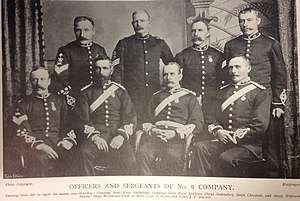1st Orkney Artillery Volunteers
The 1st Orkney Artillery Volunteers were formed in 1860 as a response to a French invasion threat. They served as a Coast Artillery unit and continued in existence until the dissolution of Coast Artillery in the UK in 1956.
| 1st Orkney Artillery Volunteers | |
|---|---|
 Number 6 Company, 1st Orkney RGA (Volunteers) in 1902 | |
| Active | 1859–1961 |
| Country | |
| Branch | |
| Type | Artillery Regiment |
| Role | Garrison Artillery Coastal Artillery Anti-Aircraft Artillery |
Artillery Volunteers 1859-1908
The 1st Orkney Artillery Volunteers was formed on 24 May 1860. By 1878 a total of ten Corps had been raised across the Orkney Islands.[1]
1st Corps formed at Kirkwall on 1 May 1860
2nd Corps formed at Scar House on the Isle of Sanday on 23 June 1863
3rd Corps formed at Balfour on Shapinsay Island on 10 July 1863
4th Corps formed at Stromness on 23 June 1863
5th Corps formed at Stronsay Island on 17 August 1865
6th Corps formed at Holm on 28 November 1866
7th Corps formed at Firth on 31 October 1868 (disbanded 1877)
8th Corps formed at Evie on 25 June 1870
9th Corps formed at Rousay on 30 December 1874
10th Corps formed at Birsay on 2 March 1878
In May 1880 the Corps were consolidated as the 1st Orkney Artillery Volunteers, with nine batteries formed in order of seniority by the nine remaining Corps. In 1902 the unit was retitled the 1st Orkney Royal Garrison Artillery (Volunteers).[2]
Territorial Force
In 1908 on the formation of the Territorial Force the corps became the Orkney Royal Garrison Artillery (TF) with a strength of seven companies and headquarters at Kirkwall.[3]
On the outbreak of the First World War, the Orkney RGA deployed to their war stations, manning fixed defences. The Companies were located as follows, with Headquarters in Kirkwall:[4]
No1 Company at Kirkwall
No2 Company at Isle of Sanday
No3 Company at Balfour on Shapinsay
No4 Company at Stromness
No5 Company at Evie
No6 Company at Holm
No7 Company at Kirkwall
They were placed in suspended animation in 1918.[5]
Interwar years
After the war, the unit was reconstituted as the Orkney Coast Brigade, RGA (TA) in the reformed Territorial Army, but was again placed in suspended animation in 1922.
In 1938 it was again reconstituted and designated the Orkney Heavy Regiment RA (TA).[6]
World War II
In July 1940 the Regiment was re-organised into three Regiments and re-designated with new numbers 533 (Orkney) Coast Regiment, RA (TA), with the other Regiments numbered 534th and 535th. These latter Regiments were placed in suspended animation in 1945, being disbanded in 1947.[7]
Postwar
In 1946 the unit was placed in suspended animation, but the following year reformed in the postwar Territorial Army as 430th Coast Regiment RA (Orkney) (TA) with Headquarters at Kirkwall.[8]
With the disbandment of Coast Artillery in the UK in 1956 the unit was reorganised as 861st (Indep) Light Anti-Aircraft Battery RA (Orkney and Zetland) (TA), with headquarters moving to Lerwick in Shetland. In 1961 the battery was amalgamated with 540th Light Anti-Aircraft Regiment (RA) (Lovat Scouts) (TA).
Notes
- Litchfield, Norman E H, and Westlake, R, 1982. The Volunteer Artillery 1859-1908, The Sherwood Press, Nottingham, p144
- Army List, His Majesty's Stationery Office, 1902
- Osborne, Mike, 2006. Always Ready: The Drill Halls of Britain's Volunteer Forces, Partizan Press, p.283
- Rinaldi, Richard A, 2008. Order of Battle of the British Army 1914, Ravi Rikhye, p276
- Litchfield, Norman E H, 1992. The Territorial Artillery 1908-1988, The Sherwood Press, Nottingham, p301.
- Litchfield, Norman E H, 1992. The Territorial Artillery 1908-1988, The Sherwood Press, Nottingham, p301
- Litchfield, Norman E H, 1992. The Territorial Artillery 1908-1988, The Sherwood Press, Nottingham, p301
- Litchfield, Norman E H, 1992. The Territorial Artillery 1908-1988, The Sherwood Press, Nottingham, p301
References
- Ian F.W. Beckett, Riflemen Form: A Study of the Rifle Volunteer Movement 1859–1908, Aldershot, The Ogilby Trusts, 1982, ISBN 0-85936-271-X.
- Jeffrey E Dorman, Orkney Coast Batteries 1914-1956, 1996
- Lt Gen Sir James Moncrieff Grierson, Records of the Scottish Volunteer Force 1859–1908, William Blackwood & Sons Ltd, 1909.
- Lt-Col H.F. Joslen, Orders of Battle, United Kingdom and Colonial Formations and Units in the Second World War, 1939–1945, London: HM Stationery Office, 1960/Uckfield: Naval & Military, 2003, ISBN 1-84342-474-6.
- Litchfield, Norman E H, and Westlake, R, 1982. The Volunteer Artillery 1859-1908, The Sherwood Press, Nottingham. ISBN 0-9508205-0-4
- Litchfield, Norman E H, 1992. The Territorial Artillery 1908-1988, The Sherwood Press, Nottingham. ISBN 0-9508205-2-0
- Osborne, Mike, 2006. Always Ready: The Drill Halls of Britain's Volunteer Forces, Partizan Press, Essex. ISBN 1-85818-509-2
- Rinaldi, Richard A (2008). Order of Battle of the British Army 1914. Ravi Rikhye. ISBN 978-0-97760728-0.